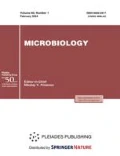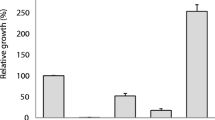Abstract—
Lactobacillus fermentum 39 is a well-known probiotic strain, which is widely used for production of pharmacopoeial probiotic preparations, dietary supplements, and foodstuffs enriched with probiotic microorganisms. In the course of analysis by transmission electron microscopy, the cell morphology was studied, biochemical properties of the strain and strain-specific characteristics of sugar metabolism were thoroughly analyzed, its full genome was sequenced, and the cluster of genes responsible for exopolysaccharide synthesis was characterized. The cells of Lactobacillus fermentum 39 were shown to be capable of adsorbing rotavirus particles, which allows us to substantiate a new aspect of application of probiotics, including this strain, in acute gastroenteritis caused by human rotaviruses.




Similar content being viewed by others
REFERENCES
Ahmadi, E., Alizadeh-Navaei, R., and Rezai, M.S., Efficacy of probiotic use in acute rotavirus diarrhea in children: a systematic review and meta-analysis, Casp. J. Intern. Med., 2015, vol. 6, pp. 187–195.
Ang, L.Y., Too, H.K., Tan, E.L., Chow, T.K., Shek, L.P., Tham, E.H., and Alonso, S., Antiviral activity of Lactobacillus reuteri protectis against Coxsackievirus A and Enterovirus 71 infection in human skeletal muscle and colon cell lines, Virol. J., 2016, vol. 13, p. 111. https://doi.org/10.1186/s12985-016-0567-6
Arena, M.P., Elmastour, F., Sane, F., Drider, D., Fiocco, D., Spano, G., and Hober, D., Inhibition of Coxsackievirus B4 by Lactobacillus plantarum, Microbiol. Res., 2018, vol. 210, pp. 59–64. https://doi.org/10.1016/j.micres.2018.03.008
Badel, S., Bernardi, T., and Michaud, P., New perspectives for lactobacilli exopolysaccharides, Biotechnol. Adv., 2011, vol. 29, pp. 54–66.
Botić, T., Klingberg, T.D., Weingart, H., and Cencic, A., A novel eukaryotic cell culture model to study antiviral activity of potential probiotic bacteria, Int. J. Food Microbiol., 2007, vol. 115, pp. 227–234. https://doi.org/10.1016/j.ijfoodmicro.2006.10.044
Castro-Bravo, N., Wells, J.M., Margolles, A., and Ruas-Madiedo, P., Interactions of surface exopolysaccharides from Bifidobacterium and Lactobacillus within the intestinal environment, Front. Microbiol., 2018, vol. 9, p. 2426. https://doi.org/10.3389/fmicb.2018.02426
Cosentino, S., Voldby, L.M., Moller, A.F., and Lund, O., Pathogen-Finder—distinguishing friend from foe using bacterial whole genome sequence data, PLoS One, 2013, vol. 8, e77302. https://doi.org/10.1371/journal.pone.0077302
Dan, T., Fukuda, K., Sugai-Bannai, M., Takakuwa, N., Motoshima, H., and Urashima, T., Characterization and expression analysis of the exopolysacharide gene cluster in Lactobacillus fermentum TDS030603, Biosci. Biotechnol. Biochem., 2009, vol. 73, pp. 2656–2664.
Ermolenko, E.I., Suvorov, A.N., and Furaeva, V.A., In vitro antiviral effect of metabolites produced by the cultures of enterococcus and lactobacilli, Proc. 6 Russ. Congr. Infectol, 2003, p. 371.
Estes, M.K. and Kapikian, A.Z., Rotaviruses, in Fields Virology, Fields, B.N., Knipe, D.M., and Howley, P.M., Eds., Philadelphia: Kluwer, 2007, pp. 1917–1973.
Gosteva, V.V., Interaction of bacteria, viruses, and eukaryotic cells under conditions of mixed infection (electron microscopic study), Cand. Sci (Biol.) Dissertation, Moscow, 1984.
Grissa, I., Vergnaud, G., and Pourcel, C., CRISPRFinder: a web tool to identify clustered regularly interspaced short palindromic repeats, Nucl. Acids Res., 2017, vol. 35, pp. 52–57.
Hammes, W.P. and Hertel, C., The genus of Lactobacillus and Carnobacterium, in The Procaryotes, Balows, A., Truper, H.G., Dworkin, M., Harder, W., and Schleifer, K.-H., Eds., vol. 4, New York: Springer, 1992, 2nd ed.
Horvatha, Ph., Coûté-Monvoisina, A.C., Romerob, D.A., Boyavala, P., Fremauxa, Ch., and Barrangoub, R., Comparative analysis of CRISPR loci in lactic acid bacteria genomes, Int. J. Food Microbiol., 2009, vol. 131, pp. 62–70. https://doi.org/10.1016/j.ijfoodmicro.2008.05.030
Isolauri, E., Probiotics for infectious diarrhea, Gut, 2003, vol. 52, pp. 436–437.
Kang, H., Gilbert, C., Badeaux, F., Atlan, D., and LaPointe, G., A tyrosine phosphorylation switch controls the interaction between the transmembrane modulator protein Wzd and the tyrosine kinase Wze of Lactobacillus rhamnosus, BMC Microbiol., 2015, vol. 15, p. 40. https://doi.org/10.1186/s12866-015-0371-2
Khusainov, I.A., Modern concepts on biosynthesis of bacterial exopolysaccharides, Vestn. Kazan. Tekhnol. Univ. 2014, vol. 17, no. 5, pp. 167–172.
Kim, K., Lee, G., Thanh, H.D., Kim, J.H., Konkit, M., Yoon, S., Park, M., Yang, S., Park, E., and Kim, W., Exopolysaccharide from Lactobacillus plantarum LRCC5310 offers protection against rotavirus-induced diarrhea and regulates inflammatory response, J. Dairy Sci., 2018, vol. 101, pp. 5702–5712. https://doi.org/10.3168/jds.2017-14151
Konyanee, A., Yotpanya, P., Panya, M., Engchanil, C., Suebwongsa, N., Namwat, W., Thaw, H., Faksri, K., Sankuntaw, N., and Lulitanond, V., Genome sequence of Lactobacillus fermentum 47-7, a good in vitro probiotic strain isolated from a healthy Thai infant, Microbiol. Res. Announc., 2019, vol. 8, e01014-19. https://doi.org/10.1128/MRA.01014-19
Lactobacillus-containing probiotics, OFS.1.7.1.0006.15. https://pharmacopoeia.ru/ofs-1-7-1-0006-15-laktosoderzhashhie-probiotiki. Accessed April 25, 2019.
Lei, S., Ramesh, A., Twitchell, E., Wen, K., Bui, T., Weiss, M., Yang, X., Kocher, J, Li, G., Giri-Rachman, E., Trang, N.V., Jiang, X., Ryan, E.P., and Yuan, L., High protective efficacy of probiotics and rice bran against human norovirus infection and diarrhea in gnotobiotic pigs, Front. Microbiol., 2016, p. 1699. https://doi.org/10.3389/fmicb.2016.01699
Majamaa, H., Isolauri, E., Saxelin, M., and Vesikari, T., Lactic acid bacteria in the treatment of acute rotavirus gastroenteritis, J. Pediatr. Gastroenterol. Nutr., 1995, vol. 3, pp. 333–338.
Makarova, K.S., Wolf, H., Alkhnbashi, O.S., Costa, F., Shah, S.A., Saunders, S.J., Barrangou, R., Brouns, S.J.J., Charpentier, E., Haft, D.H., Horvath, P., Moineau, S., Mojica, F.J.M., Terns, R.M., Terns, M.P., et al., An updated evolutionary classification of CRISPR-Cas systems, Nat. Rev. Microbiol., 2015, pp. 722–736. https://doi.org/10.1038/nrmicro3569
Oleksy, M. and Klewicka, E., Exopolysaccharides produced by Lactobacillus sp.: biosynthesis and applications, Crit. Rev. Food Sci. Nutr., 2018, vol. 58, pp. 450–462. https://doi.org/10.1080/10408398.2016.1187112
Platonov, M.E., Evseeva, V.V., Dentovskaya, S.V., and Anisimov, A.P., Molecular typing of Yersinia pestis, Mol. Genet. Microbiol. Virol., 2013, vol. 28, pp. 41–51.
Ravin, N.V. and Shestakov, S.V., The genome of prokaryotes, Russ. J. Gen.: Appl. Res., 2013, vol. 17, pp. 972–984.
Salminen, S., Bouley, C., Boutron-Ruault, M.C., Cummings, J.H., Franck, A., Gibson, G.R., Isolauri, E., Moreau, M.C., Roberfroid, M., and Rowland, I., Functional food science and gastrointestinal physiology and function, Br. J. Nutr., 1998, vol. 80, pp. S147–S171.
Seemann, T., Prokka: rapid prokaryotic genome annotation, Bioinformatics, 2014, vol. 30, pp. 2068–2069. https://doi.org/10.1093/bioinformatics/btu153
Shelkovaya, N.G., Kupchinskii, L.G., Znamenskii, V.A., and Bondarenko, V.M., Electron microscopic investigation of the interaction of bacterial intestinal microflora and rotavirus virions, Zh. Mikrobiol. Epidemiol. Immunobiol., 1991, no. 9, pp. 18–21.
Sunmola, A.A., Ogbole, O.O., Faleye, T.O.C., Adetoye, A., Adeniji, J.A., and Ayeni, F.A., Antiviral potentials of Lactobacillus plantarum, Lactobacillus amylovorus, and Enterococcus hirae against selected Enterovirus, Folia Microbiol., 2019, vol. 64, pp. 257–264. https://doi.org/10.1007/s12223-018-0648-6
The Firmicutes, in Bergey’s Manual of Systematic Bacteriology, Vos, P., Garrity, G., Jones D., Krieg, N.R., Ludwig, W., Rainey, F.A., Schleifer, K.-H., and Whitman, W.B., Eds., New York: Springer, 2009, vol. 3, 2nd ed.
Virology. A Practical Approach, Mahy, B.W., Ed., Oxford: IRL, 1985.
Zankari, E., Hasman, H., Cosentino, S., Vestergaard, M., Rasmussen, S., Lund, O., Aarestrup, F.M., and Larsen, M.V., Identification of acquired antimicrobial resistance genes, J. Antimicrob. Chemother., 2012, vol. 67, pp. 2640–2644. https://doi.org/10.1093/jac/dks261
Author information
Authors and Affiliations
Corresponding author
Ethics declarations
The authors declare that they have no conflict of interest. This article does not contain any studies involving animals or human participants performed by any of the authors.
Additional information
Translated by E. Makeeva
Rights and permissions
About this article
Cite this article
Soloveva, I.V., Novikova, N.A., Tochilina, A.G. et al. The Probiotic Strain Lactobacillus fermentum 39: Biochemical Properties, Genomic Features, and Antiviral Activity. Microbiology 90, 219–225 (2021). https://doi.org/10.1134/S0026261721020132
Received:
Revised:
Accepted:
Published:
Issue Date:
DOI: https://doi.org/10.1134/S0026261721020132




